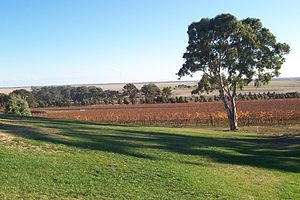- Limestone Coast
-
The Limestone Coast is a name used since the early twentyfirst century for the geographical region and tourist region of the southeast coast of South Australia from the Victoria border to the towards the city of Adelaide.
Contents
Location and description
From the Victoria border to the Younghusband Peninsula this coast has been settled since the 1840s and supports farming, viticulture, forestry and tourism. Towns of the coast include Bordertown, Keith, Millicent, Mount Gambier, Penola, and Naracoorte, the coastal resorts of Beachport, Kingston SE and Robe, and the wine-growing regions of Coonawarra, Padthaway, Wrattonbully and Mount Benson.
Much of the Limestone Coast region is low-lying, and was inundated by sea as recently as 2 million years ago. It had previously also been flooded 15–20 million years ago. The plains are lined by rows of low sandhills parallel to the coast, created at times when the coastline was at that level. Prior to white settlement, much of the land between the sandhills was swamp fed by streams and subject to inundation. A network of drains totalling 1450 km has been constructed to channel the water away through the sandhills to the ocean. Important areas of wetland remain including the lakes and lagoons around the Murray Mouth, where the huge Murray River, by now reduced by draining off into the dry plains of Australia, finally meets the ocean between the Younghusband and the Sir Richard Peninsulas via a series of shallow lagoons including the Coorong, Lake Albert, Lake Alexandrina and Bool Lagoon. Meanwhile areas of upland behind the Limestone Coast include the volcanic craters of Mount Gambier.
The Mediterranean climate of this coast is cool and moist with wet winters.
History
There are deep limestone deposits created form the coral and other sealife. The limestone in Victoria Fossil Cave and the other Naracoorte Caves contains are Australia's biggest source of fossils and a World Heritage site.
Flora
The natural vegetation was woodland of River Red Gum and other eucalyptus trees.[1]
Fauna
Although there are few purely endemic species the coast is rich in wildlife including possums, Cercartetus pygmy possums, Petaurus Gliding possums, and other marsupials many of which do not spread further west than here. Endemic species include reptiles such as the Striped Legless Lizard (Delma impar) and invertebrates like an endemic cave cricket. The Naracoorte caves are occupied by the Common Bent-wing Bat.
The lakes and lagoons are particularly important habitats for waterbirds such as Black Swan, Grey Teal, Pacific Black Duck, and especially the critically endangered Orange-bellied Parrot (Neophema chrysogaster) which winters here along with many other birds including the Red-necked Stint (Calidris ruficollis), Sharp-tailed Sandpiper (Calidris acuminata), and Curlew sandpiper (Calidris ferruginea).
Most of the original habitat has been cleared for agriculture and only fragments remain (particularly in areas of wetland) with Coorong National Park, Messent Conservation Park, and Canunda National Park being the largest areas. Therefore most indigenous wildlife has also disappeared or been severely reduced in number with introduced species of animals an ongoing threat to that which remains.
References
External links
- Regional Website - Local Weather, Street Maps, Events etc
- Official Tourist Website
- SouthAustralia.com Limestone Coast - Travel Guides, Accommodation, Online Booking
- Limestone Coast parks brochure (pdf) - Department for Environment and Heritage
South Australia Topics History · Government · Flag · Culture · Transport · Rail transport · Education · Geography · Geology · South Australian English · Sport · Country Fire Service
Regions Adelaide Hills · Barossa Valley · Clare Valley · Eyre Peninsula · Far North · Fleurieu Peninsula · Flinders Ranges · Limestone Coast · Mid North · Murraylands · Nullarbor Plain · Riverland · Yorke PeninsulaCities and towns Adelaide · Port Augusta · Mount Gambier · Murray Bridge · Port Lincoln · Port Pirie · Victor Harbor · WhyallaCategories:- Limestone Coast
- IBRA regions
- Ecoregions of Australia
- Mediterranean forests, woodlands, and scrub
Wikimedia Foundation. 2010.


